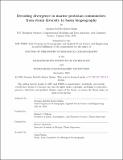Decoding divergence in marine protistan communities: from strain diversity to basin biogeography
Author(s)
Krinos Quinn, Arianna Isabella
DownloadThesis PDF (61.41Mb)
Advisor
Follows, Michael J
Alexander, Harriet
Terms of use
Metadata
Show full item recordAbstract
Protists (microbial eukaryotes) in the global ocean are critical components of primary
productivity and nutrient recycling. Protists are genetically diverse and have distinctive
ecological niches based on genetically-driven differences in physiological fitness. A deeper
understanding of which dimensions of protistan genetic diversity translate to measurable phenotypic variation is needed to predict the impact of protists on marine biogeochemistry and
protists’ environmental change sensitivity. I cultured twelve strains of the coccolithophore
Gephyrocapsa huxleyi across temperatures, which revealed strain-specific differences in thermal optima and niche widths. I used traits measured during the experiments to design
a Darwin ecosystem model simulation, which demonstrated basin-specific biogeography of
thermal optima and niche widths (Chapter 2). For seven of the twelve strains, I sequenced
transcriptomes at 3-5 temperatures to assess gene expression variation. Using the RNAseq
data, I developed a regression modeling approach to identify proteome allocation model parameters. Combining differential expression analysis, gene abundance normalization, and the
regression model to explore the proteome allocation model parameter space, I probed differences in modeled strategies of G. huxleyi strains in response to temperature (Chapter 3).
Scalable workflows highlight the challenge and promise of meta-omic data to link community
structure to physiology. I developed a pipeline for metatranscriptome analysis and taxonomic
annotation to address the lack of tools built specifically for microbial eukaryotes, and created mock communities to assess recovery success in protistan metatranscriptome analysis
workflows (Chapters 4 and 5). I applied these tools to a three-year metatranscriptomic
dataset from Cape Cod Bay to investigate a recent emergence of a summer coccolithophore
population in the 20-year time series, tracking shifts in nutrient physiology to identify potential bottom-up controls (Chapter 6). This dissertation advances approaches to constrain
the protistan taxonomic diversity that underlies shifts in global primary productivity and
nutrient turnover. Specifically, strains of a single phytoplankton species revealed diversity
relevant to a global ecosystem model. Future work will clarify variability in protistan gene
content and expression that may underpin both protists’ present ecological niches and their
future climate change response.
Date issued
2024-09Department
Joint Program in Oceanography/Applied Ocean Science and Engineering; Massachusetts Institute of Technology. Department of Earth, Atmospheric, and Planetary SciencesPublisher
Massachusetts Institute of Technology